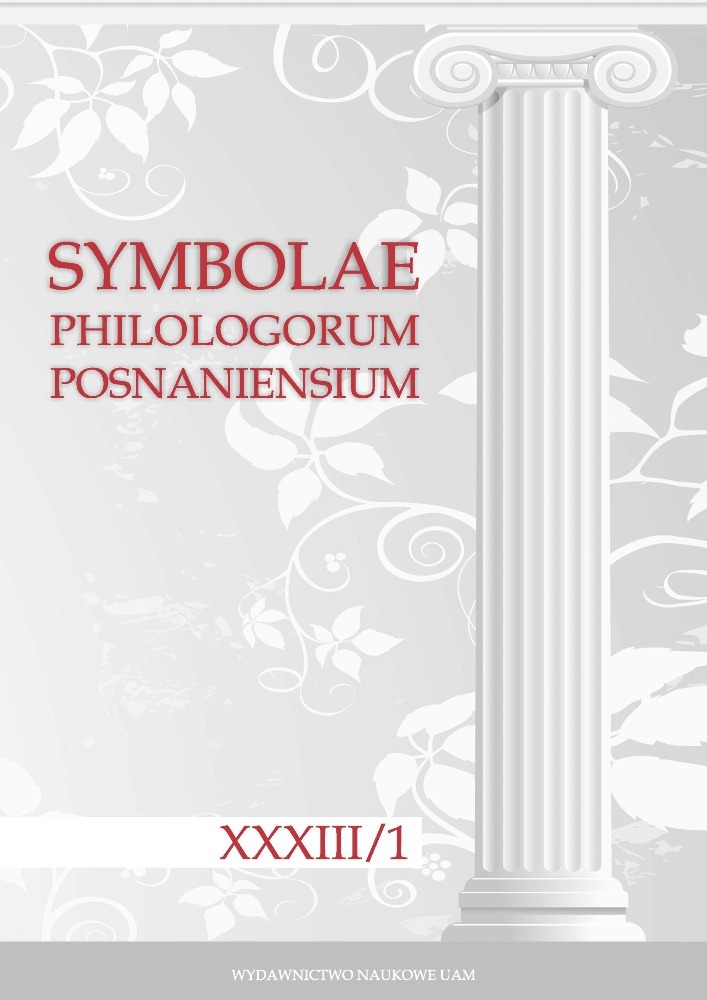Abstrakt
Epithets used to describe the Muses are an essential component of metapoetic language, starting as early as the time of Homer and Hesiod. However, it has never been a static phenomenon, as the cultural transformations entailed the changes in the language describing the Muses. Its scope included physical appearance, ancestry, voice/sound, relations with the poet/musician and – a rather important aspect – geographical associations. Revealing traces of this imagery is not an easy task: we lack cult hymns, and in most literary works, we encounter merely 2–3 epithets at the most. In this respect, Ovid is exceptional. In his Metamorphoses (5,254–6,2), in the story of the contest between the Muses of Helicon and the false Pierides, the poet deploys a uniquely rich descriptive terminology concerning the Muses (Mnemonides, Thespiades, Aonides, Emathides, [Pierides], doctae sorores, etc.). In this article, I look at the poet’s choices in this story and analyze the origins, functions and connotations of the epithets and terms he uses.
Bibliografia
Berman 2015: Berman, D.W. 2015. Myth, Literature, and the Creation of the Topography of Thebes. Cambridge. DOI: https://doi.org/10.1017/CBO9781139924863
Bing 1988: Bing, P. 1988. Well-read Muse. Present and Past in Callimachus and the Hellenistic Poets. Göttingen. DOI: https://doi.org/10.13109/9783666251894
Bömer 1976: Bömer, F. 1976. P. Ovidius Naso Metamorphosen: Kommentar, Buch IV-VI. Heidelberg.
Calame 1997: Calame, C. 1997. Choruses of Young Women in Ancient Greece. Their Morphology, Religious Role, and Social Function. Transl. by D. Collins, J. Orion. Lanham (1 ed.: Rome 1977).
Hawes 2014: Hawes, G. 2014. Rationalizing Myth in Antiquity. Oxford. DOI: https://doi.org/10.1093/acprof:oso/9780199672776.001.0001
Hinds 1987: Hinds, S. 1987. The Metamorphosis of Persephone. Ovid and the self-conscious Muse. Cambridge.
Johnson 2008: Johnson, P.J. 2008. Ovid before Exile. Art and Punishment in the ‘Metamorphoses’. Madison.
Johnson 1988: Johnson, P.J., Malamud M. 1988. “Ovid’s ‘Musomachia’.” Pacific Coast Philology 23.1/2: 30–38. DOI: https://doi.org/10.2307/1316682
Kuttner 1995: Kuttner, A. 1995. “Republican Rome Looks at Pergamon.” Harvard Studies in Classical Philology 97: 157–178. DOI: https://doi.org/10.2307/311304
LeVen 2021: LeVen, P. 2021. Music and Metamorphosis in Graeco-Roman Thought. Cambridge. DOI: https://doi.org/10.1017/9781316563069
Manieri 2009: Manieri, A. 2009. Agoni poetico-musicali nella Grecia antica, vol. I: Beozia. Roma.
MacLeod 2000: MacLeod, R. (ed.) 2000. The Library of Alexandria. Centre of Learning in the Ancient World. London and New York.
McPhee 2019: McPhee, B.D. 2019. “(Adhvc) virgineusque Helicon: A Subtextual Rape in Ovid’s Catalogue of Mountains (Met. 2,219)”. Classical Quarterly 69.2: 769–775. DOI: https://doi.org/10.1017/S0009838819000922
Mojsik 2019: Mojsik, T. 2019. “From Hesiod’s Tripod to Thespian Mouseia. Archaeological Evidence and Cultural Contexts.” Klio 101.2: 405–426. DOI: https://doi.org/10.1515/klio-2019-0036
Mojsik 2022: Mojsik, T. 2022. Orpheus in Macedon: Myth, Cult, and Ideology. London and New York. DOI: https://doi.org/10.5040/9781350213210
Queyrel 1988: Queyrel, A. 1988, “Les Muses à l’école: Images de quelques vases du peintre de Calliope.” Antike Kunst 31.2: 90–102.
Ridgway 2001: Ridgway, B.S. 2001. Hellenistic Scuplpture I. Bristol.
Robinson 2012: Robinson, B.A. 2012. “Mount Helikon and the Valley of the Muses. The Production of a Sacred Space.” Journal of Roman Archaeology 25: 227–258. DOI: https://doi.org/10.1017/S1047759400001203
Rosati, Chiarini 2009: Rosati, G.; Chiarini, G. 2009. Publio Nasone Ovidio, Metamorfosi. Libri V-VI. Testo latino a fronte, vol. 3. Fondazione Lorenzo Valla.
Schachter 1986: Schachter, A. 1986. Cults of Boeotia, vol. II: Herakles to Poseidon. London.
Sharrock 2002: Sharrock, A. 2002. “An A-musing Tale: Gender, Genre and Ovid’s Battles with Inspiration in the Metamorphoses.” In Cultivating the Muse: Struggles for Power and Inspiration in Classical Literature. Ed. by E. Spentzou, D. Fowler, 207—227. Oxford.
Schröter 1977: Schröter, E. 1977. Ikonographie des Themas Parnass vor Raffael. Hildesheim, NY.
Stewart 2000: Stewart, A. 2000. “Pergamo Ara Marmorea Magna, On the Date, Reconstruction, and Functions of the Great Altar of Pergamon.” In From Pergamon to Sperlonga, Sculpture and Context. Ed. by N.T. De Grummond, B.S. Ridgway, 33–57. Berkeley, LA, London. DOI: https://doi.org/10.1525/9780520924833-006
Taback 2002: Taback, N. 2002. Untangling the Muses. A Comprehensive Study of Sculptures of Muses in the Greek and Roman World. unpublished PhD thesis, Harvard University.


